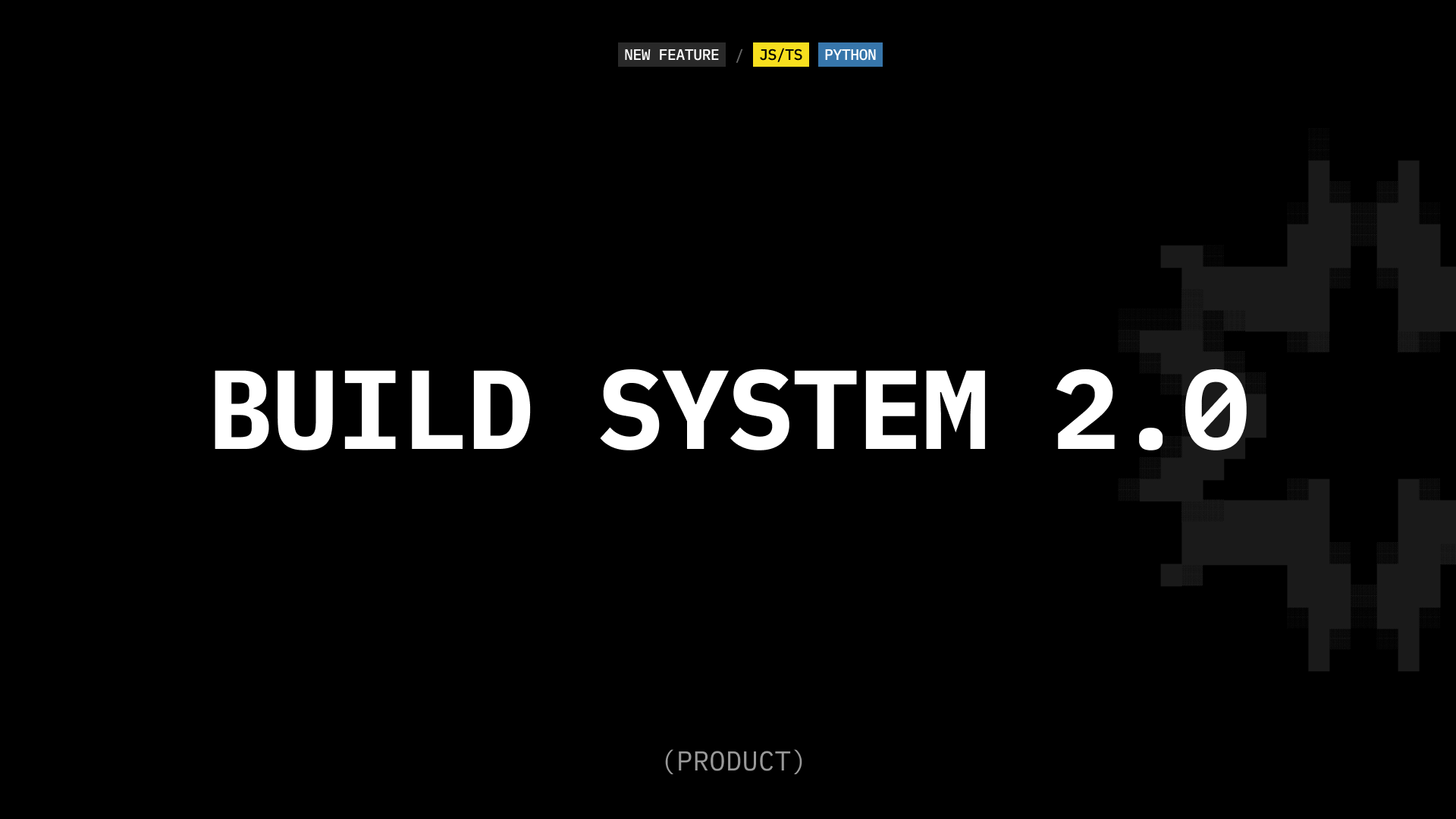Introducing Build System 2.0

We’ve released E2B Build System 2.0 — a faster and simpler way to create custom sandboxes in E2B.
With the new system you don’t need Dockerfiles, extra config files, or manual CLI build commands. You just write code. The build step still exists, but it runs automatically when you execute your template.
Why we rebuilt it
The old build system was functional, but:
- Required juggling config files, Dockerfiles, and CLI commands.
- Builds were slow, mostly local, and debugging was painful.
- Hard to expose or extend build logic for your own users.
Build System 2.0 addresses these problems head-on.
What’s new
1. Better Developer Experience
- Before: e2b template build + config + Dockerfile
- Now: Just run your code → the template builds automatically/
What previously took a config file, a Docker file, and running a terminal command is now just running a script with a few lines of code. This enables type hints, linters, dynamic builds inside apps, and exposing build logic directly to users.
Javascript:
Template()
.fromImage("node:24")
.copy("src/", ".")
.runCmd("npm install")
Python:
Template()
.from_image("node:24")
.copy("src/", ".")
.run_cmd("npm install")
2. Agentic Experience
Templates are now expressed as code, so AI IDEs and agents like Cursor or Claude Codecan parse, suggest, and generate them without extra config.
This makes it straightforward to plug the build system into an LLM as a tool.
3. Speed
- Intelligent caching
- Parallel uploads
- Server-side optimizations
Builds are up to 14× faster when cached, and ~2× faster without cache.
They now run on E2B infra — making the feedback loops shorter, performance more stable, and have clearer error messages.
4. Painless Migration
We kept backwards compatibility and added multiple migration paths:
e2b template migrate(CLI)Template().fromDockerfile()/Template(path).from_dockerfile(path)→ parses your DockerfilefromImage(tag)/from_image(tag)→ continue building from an existing base image
Helper Methods
The API now includes helpers for common tasks such as:
JavaScript
Template()
.fromUbuntu("24.04")
.pipInstall(["numpy", "pandas"])
.aptInstall(["curl", "wget"])
.gitClone("https://github.com/user/repo.git", { branch: "main" })
.setEnvs({ DEBUG: "true" })
.runCmd("npm start")
Python
Template()
.from_ubuntu("24.04")
.pip_install(["numpy", "pandas"])
.apt_install(["curl", "wget"])
.git_clone("https://github.com/user/repo.git", branch="main")
.set_envs({ DEBUG: "true" })
.run_cmd("npm start")
Get Started with Build System 2.0
If you’re on the latest E2B SDK, you already have Build System 2.0. Here’s how to try it out:
1. Install or update the SDK
Make sure you’re on the newest version:
JavaScript
npm install e2b@latest
Python
pip install --upgrade e2b
2. Create a simple template
Define your build directly in code:
JavaScript
import { Template, waitForPort } from "e2b"
const template = Template()
.fromImage("node:24")
.copy("src/", ".")
.runCmd("npm install")
.setStartCmd("npm start", waitForPort(3000))
Python
from e2b import Template, wait_for_port
template = (
Template()
.from_image("python:3.11")
.pip_install(["requests", "numpy"])
.copy("app.py", ".")
.run_cmd("python app.py", wait_for_port(3000))
)
3. Build the template
The build step is automatic — just run code:
JavaScript
await Template.build(template, {
alias: "my-template",
onBuildLogs: defaultBuildLogger(),
})
Python
Template.build(template, alias="my-template", on_build_logs=default_build_logger())4. Run your sandbox
Once the template is built, launch a sandbox from it:
JavaScript
import { Sandbox } from "e2b"
const sandbox = await Sandbox.create("my-template")
const result = await sandbox.commands.run("echo Hello E2B")
console.log(result.output)
Python
from e2b import Sandbox
sandbox = Sandbox.create("my-template")
result = sandbox.commands.run("echo Hello E2B")
print(result.output)
5. Migrating existing templates
If you already have templates built with the old system, you can migrate:
e2b template migrate
Or update your code with:
JavaScript
Template().fromDockerfile("./e2b.Dockerfile")
Python
Template().from_dockerfile("./e2b.Dockerfile").
Resources
Secure AI Sandbox
.png)



